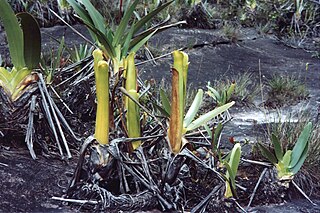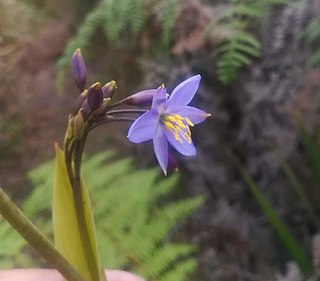
Brocchinia reducta is one of a few carnivorous bromeliads. It is native to southern Venezuela, Brazil, Colombia, and Guyana, and is found in nutrient-poor soil. B. reducta adapts to different environments, when growing on rocks it uses its roots as anchors.
Thoracocarpus is a genus of plants first described as a genus in 1958. It contains only one known species, Thoracocarpus bissectus a hemiepiphytic vine. It is native to Costa Rica, Panama, Cuba, Trinidad and Tobago, and South America.
Triuris is a genus in the family Triuridaceae. It consists of species that are small and achlorophyllous, occurring in tropical Mexico, Guatemala, and northern South America.

Ocimum americanum, known as American basil, lime basil, or hoary basil, is a species of annual herb in the family Lamiaceae. Despite the misleading name, it is native to Africa, the Indian Subcontinent, China, and Southeast Asia. The species is naturalized in Queensland, Christmas Island, and parts of tropical America.

Aechmea gigantea is a plant species in the genus Aechmea. This species is endemic to Venezuela.
Aechmea egleriana is a plant species in the genus Aechmea. This species is native to Venezuela, French Guiana and northern Brazil.

Catopsis floribunda is a species in the genus Catopsis. This species is native to the West Indies, Venezuela, Honduras, Oaxaca, and Florida.
Stalkya is a monotypic genus of flowering plants from the orchid family, Orchidaceae. The sole species is Stalkya muscicola, endemic to the Mérida region of Venezuela. It is named after the orchidologist G. C. K. "Stalky" Dunsterville.
Cyperus laxus is a sedge species in the Cyperaceae. It is native to tropical regions of the Western Hemisphere and also to Africa. The species is reportedly naturalized in Assam and the Andaman and Nicobar Islands.

Amasonia is a genus of plants in the family Lamiaceae, native to South America and to the island of Trinidad.

Acmella uliginosa, the marsh para cress, is a species of flowering herb in the family Asteraceae. The plant is native to South America and is naturalized in parts of Asia and Africa.
Hylaeorchis is a genus of epiphytic orchids. There is only one known species, Hylaeorchis petiolaris, native to northwestern South America.
Soridium is a genus of parasitic plants in the Triuridaceae, lacking chlorophyll and obtaining nutrients from fungi in the soil. It contains only one known species, Soridium spruceanum, native to Brazil, Venezuela, Suriname, French Guiana, Belize and Guatemala.

Excremis is a genus of herbs in the family Asphodelaceae, first described as a genus in 1829. There are only one known species, Excremis coarctata, native to South America.
Achlyphila is a genus of plants in the Xyridaceae, first described as a genus in 1960. It contains only one known species, Achlyphila disticha, endemic to the Serranía de la Neblina National Park in the State of Amazonas in southern Venezuela, very close to the border with Brazil.
Aratitiyopea is a monotypic genus of flowering plants, in the family Xyridaceae containing the single species Aratitiyopea lopezii. The genus was erected and described in 1984. This species is native to northern South America.

Dictyostega is a genus of flowering plants in the Burmanniaceae, first described as a genus in 1840. It contains only one known species, Dictyostega orobanchoides, native to southern Mexico, Central America, Trinidad, and South America ).
Diploon is a genus of plant in the family Sapotaceae described as a genus in 1946.
Thurnia is a group of herbaceous plants described as a genus in 1883.
Paul Edward Berry is an American botanist and curator. He is Director of the Wisconsin State Herbarium.







